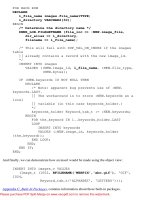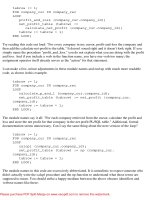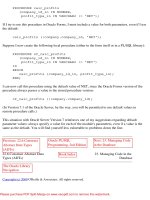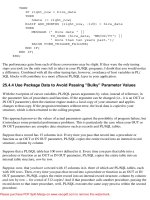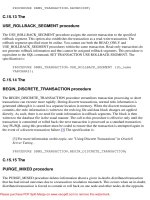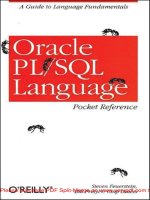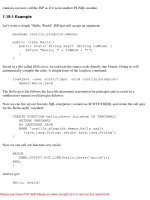Oracle PL/SQL Programming
Bạn đang xem bản rút gọn của tài liệu. Xem và tải ngay bản đầy đủ của tài liệu tại đây (3.15 MB, 984 trang )
[Appendix A] What's on the Companion Disk?
Table of Contents
A. What's on the Companion Disk?..................................................................................................................2
A.1 Installing the Guide...........................................................................................................................2
...............................................................................................................................................................................3
A.2 Using the Guide................................................................................................................................3
...............................................................................................................................................................................5
B. Calling Stored Procedures from PL/SQL Version 1.1................................................................................6
B.1 Using Stubs to Talk to Server−Side PL/SQL....................................................................................7
...............................................................................................................................................................................9
B.2 Restrictions on Calling Stored Procedures........................................................................................9
B.2.1 No Server−Side PL/SQL Datatypes..................................................................................9
B.2.2 No Direct Stored Package Variable References..............................................................10
B.2.3 No Direct Remote Procedure Calls.................................................................................12
B.2.4 No Default Parameter Values..........................................................................................12
.............................................................................................................................................................................14
C. Built−In Packages........................................................................................................................................15
C.1 Using the Built−in Packages...........................................................................................................16
.............................................................................................................................................................................18
C.2 DBMS_ALERT...............................................................................................................................18
C.2.1 The REGISTER procedure.............................................................................................18
C.2.2 The REMOVE procedure................................................................................................18
C.2.3 The REMOVEALL procedure........................................................................................18
C.2.4 The SET_DEFAULTS procedure...................................................................................18
C.2.5 The SIGNAL procedure..................................................................................................18
C.2.6 The WAITANY procedure.............................................................................................19
C.2.7 The WAITONE procedure..............................................................................................19
.............................................................................................................................................................................20
C.3 Oracle AQ, the Advanced Queueing Facility..................................................................................20
C.3.1 DBMS_AQ (PL/SQL 8 Only).........................................................................................20
C.3.2 DBMS_AQADM (PL/SQL 8 Only)...............................................................................21
.............................................................................................................................................................................24
C.4 DBMS_DDL...................................................................................................................................24
C.4.1 The ALTER_COMPILE procedure................................................................................24
C.4.2 The ANALYZE_OBJECT procedure.............................................................................24
.............................................................................................................................................................................25
C.5 DBMS_ JOB...................................................................................................................................25
C.5.1 The BROKEN procedure................................................................................................25
C.5.2 The CHANGE procedure................................................................................................25
C.5.3 The INTERVAL procedure.............................................................................................25
C.5.4 The ISUBMIT procedure................................................................................................25
C.5.5 The NEXT_DATE procedure.........................................................................................26
C.5.6 The REMOVE procedure................................................................................................26
C.5.7 The RUN procedure........................................................................................................26
C.5.8 The SUBMIT procedure.................................................................................................26
C.5.9 The USER_EXPORT procedure.....................................................................................26
C.5.10 The WHAT procedure...................................................................................................26
.............................................................................................................................................................................28
C.6 DBMS_LOB (PL/SQL8 Only).......................................................................................................28
C.6.1 The APPEND procedure.................................................................................................28
C.6.2 The COMPARE function................................................................................................28
C.6.3 The COPY procedure......................................................................................................29
[Appendix A] What's on the Companion Disk?
i
Table of Contents
C.6.4 The ERASE procedure....................................................................................................29
C.6.5 The FILECLOSE procedure...........................................................................................29
C.6.6 The FILECLOSEALL procedure....................................................................................29
C.6.7 The FILEEXISTS function.............................................................................................29
C.6.8 The FILEGETNAME procedure.....................................................................................29
C.6.9 The FILEISOPEN function.............................................................................................30
C.6.10 The FILEOPEN procedure............................................................................................30
C.6.11 The GETLENGTH function.........................................................................................30
C.6.12 The INSTR function......................................................................................................30
C.6.13 The READ procedure....................................................................................................30
C.6.14 The SUBSTR function..................................................................................................31
C.6.15 The TRIM procedure.....................................................................................................31
C.6.16 The WRITE procedure..................................................................................................31
.............................................................................................................................................................................33
C.7 DBMS_LOCK.................................................................................................................................33
C.7.1 The ALLOCATE_UNIQUE procedure..........................................................................33
C.7.2 The CONVERT function................................................................................................33
C.7.3 The RELEASE function..................................................................................................34
C.7.4 The REQUEST function.................................................................................................34
C.7.5 The SLEEP procedure.....................................................................................................34
.............................................................................................................................................................................36
C.8 DBMS_MAIL.................................................................................................................................36
C.8.1 The SEND procedure......................................................................................................36
.............................................................................................................................................................................37
C.9 DBMS_OUTPUT............................................................................................................................37
C.9.1 The DISABLE procedure................................................................................................37
C.9.2 The ENABLE procedure.................................................................................................37
C.9.3 The GET_LINE procedure..............................................................................................37
C.9.4 The GET_LINES procedure...........................................................................................37
C.9.5 The NEW_LINE procedure............................................................................................37
C.9.6 The PUT procedure.........................................................................................................38
C.9.7 The PUT_LINE procedure..............................................................................................38
.............................................................................................................................................................................39
C.10 DBMS_PIPE.................................................................................................................................39
C.10.1 The CREATE_PIPE function.......................................................................................39
C.10.2 The NEXT_ITEM_TYPE function...............................................................................39
C.10.3 The PACK_MESSAGE procedure...............................................................................40
C.10.4 The PURGE procedure.................................................................................................40
C.10.5 The RECEIVE_MESSAGE function............................................................................40
C.10.6 The REMOVE_PIPE function......................................................................................40
C.10.7 The RESET_BUFFER procedure.................................................................................40
C.10.8 The SEND_MESSAGE function..................................................................................41
C.10.9 The UNIQUE_SESSION_NAME function..................................................................41
C.10.10 The UNPACK_MESSAGE procedure.......................................................................41
.............................................................................................................................................................................42
C.11 DBMS_ROWID (PL/SQL8 Only)................................................................................................42
C.11.1 The ROWID_CREATE function..................................................................................42
C.11.2 The ROWID_INFO procedure......................................................................................42
C.11.3 The ROWID_TYPE function........................................................................................42
C.11.4 The ROWID_OBJECT function...................................................................................42
C.11.5 The ROWID_RELATIVE_FNO function....................................................................43
C.11.6 The ROWID_BLOCK_NUMBER function.................................................................43
[Appendix A] What's on the Companion Disk?
ii
Table of Contents
C.11.7 The ROWID_ROW_NUMBER function.....................................................................43
C.11.8 The ROWID_TO_ABSOLUTE_FNO function...........................................................43
C.11.9 The ROWID_TO_EXTENDED function.....................................................................43
C.11.10 The ROWID_TO_RESTRICTED function................................................................43
C.11.11 The ROWID_VERIFY function.................................................................................43
.............................................................................................................................................................................45
C.12 DBMS_SESSION.........................................................................................................................45
C.12.1 The CLOSE_DATABASE_LINK procedure...............................................................45
C.12.2 The IS_ROLE_ENABLED function.............................................................................45
C.12.3 The RESET_PACKAGE procedure.............................................................................45
C.12.4 The SET_LABEL procedure.........................................................................................45
C.12.5 The SET_NLS_LABEL procedure...............................................................................45
C.12.6 The SET_NLS procedure..............................................................................................45
C.12.7 The SET_ROLE procedure...........................................................................................46
C.12.8 The SET_SQL_TRACE procedure...............................................................................46
C.12.9 The UNIQUE_SESSION_ID function.........................................................................46
.............................................................................................................................................................................47
C.13 DBMS_SNAPSHOT.....................................................................................................................47
C.13.1 The DROP_SNAPSHOT procedure.............................................................................47
C.13.2 The GET_LOG_AGE procedure..................................................................................47
C.13.3 The PURGE_LOG procedure.......................................................................................47
C.13.4 The REFRESH procedure.............................................................................................47
C.13.5 The REFRESH_ALL procedure...................................................................................48
C.13.6 The SET_UP procedure................................................................................................48
C.13.7 The WRAP_UP procedure............................................................................................48
.............................................................................................................................................................................49
C.14 DBMS_SQL..................................................................................................................................49
C.14.1 The BIND_ARRAY procedure.....................................................................................49
C.14.2 The BIND_VARIABLE procedure...............................................................................49
C.14.3 The CLOSE_CURSOR procedure................................................................................50
C.14.4 The COLUMN_VALUE procedure..............................................................................50
C.14.5 The DEFINE_COLUMN procedure.............................................................................51
C.14.6 The EXECUTE function...............................................................................................51
C.14.7 The EXECUTE_AND_FETCH function......................................................................52
C.14.8 The FETCH_ROWS function.......................................................................................52
C.14.9 The IS_OPEN function.................................................................................................52
C.14.10 The LAST_ERROR_POSITION function..................................................................52
C.14.11 The LAST_ROW_COUNT function..........................................................................52
C.14.12 The LAST_ROW_ID function....................................................................................52
C.14.13 The LAST_SQL_FUNCTION_CODE function.........................................................52
C.14.14 The OPEN_CURSOR function...................................................................................53
C.14.15 The PARSE procedure................................................................................................53
C.14.16 The VARIABLE_VALUE procedure.........................................................................53
.............................................................................................................................................................................54
C.15 DBMS_TRANSACTION.............................................................................................................54
C.15.1 The ADVISE_COMMIT procedure.............................................................................54
C.15.2 The ADVISE_NOTHING procedure............................................................................54
C.15.3 The ADVISE_ROLLBACK procedure........................................................................54
C.15.4 The COMMIT procedure..............................................................................................55
C.15.5 The COMMIT_COMMENT procedure........................................................................55
C.15.6 The COMMIT_FORCE procedure...............................................................................55
C.15.7 The READ_ONLY procedure.......................................................................................55
[Appendix A] What's on the Companion Disk?
iii
Table of Contents
C.15.8 The READ_WRITE procedure.....................................................................................55
C.15.9 The ROLLBACK procedure.........................................................................................56
C.15.10 The ROLLBACK_FORCE procedure........................................................................56
C.15.11 The ROLLBACK_SAVEPOINT procedure...............................................................56
C.15.12 The SAVEPOINT procedure......................................................................................56
C.15.13 The USE_ROLLBACK_SEGMENT procedure.........................................................56
C.15.14 The BEGIN_DISCRETE_TRANSACTION procedure.............................................56
C.15.15 The PURGE_MIXED procedure................................................................................57
C.15.16 The PURGE_LOST_DB procedure............................................................................57
C.15.17 The LOCAL_TRANSACTION_ID function.............................................................57
C.15.18 The STEP_ID function................................................................................................57
.............................................................................................................................................................................59
C.16 DBMS_UTILITY..........................................................................................................................59
C.16.1 The ANALYZE_SCHEMA procedure.........................................................................59
C.16.2 The COMMA_TO_TABLE procedure.........................................................................59
C.16.3 The COMPILE_SCHEMA procedure..........................................................................59
C.16.4 The FORMAT_CALL_STACK function.....................................................................59
C.16.5 The FORMAT_ERROR_STACK function..................................................................59
C.16.6 The GET_TIME function..............................................................................................60
C.16.7 The IS_PARALLEL_SERVER function......................................................................60
C.16.8 The NAME_RESOLVE procedure...............................................................................60
C.16.9 The NAME_TOKENIZE procedure.............................................................................60
C.16.10 The PORT_STRING function.....................................................................................61
C.16.11 The TABLE_TO_COMMA procedure.......................................................................61
.............................................................................................................................................................................62
C.17 UTL_FILE.....................................................................................................................................62
C.17.1 Setting Up UTL_FILE..................................................................................................62
.............................................................................................................................................................................65
1. Introduction to PL/SQL...............................................................................................................................66
1.1 What Is PL/SQL?.............................................................................................................................66
.............................................................................................................................................................................68
1.2 The Concept of Programming in Oracle Applications....................................................................68
.............................................................................................................................................................................70
1.3 The Origins of PL/SQL....................................................................................................................70
1.3.1 Improved Application Portability with PL/SQL..............................................................70
1.3.2 Improved Execution Authority and Transaction Integrity with PL/SQL........................71
.............................................................................................................................................................................72
1.4 PL/SQL Versions.............................................................................................................................72
1.4.1 Working with Multiple Versions of PL/SQL..................................................................72
1.4.2 How This Book Handles Different Versions of PL/SQL................................................73
1.4.3 PL/SQL Version 2.0........................................................................................................73
1.4.4 PL/SQL Release 2.1.........................................................................................................80
1.4.5 PL/SQL Release 2.2.........................................................................................................82
1.4.6 PL/SQL Release 2.3.........................................................................................................83
1.4.7 PL/SQL Version 8.0........................................................................................................84
1.4.8 PL/SQL Release 1.1.........................................................................................................86
.............................................................................................................................................................................88
1.5 Advice for Oracle Programmers......................................................................................................88
1.5.1 Take a Creative, Even Radical Approach........................................................................88
1.5.2 Get Ready to Establish New Habits.................................................................................88
1.5.3 Assume that PL/SQL Has What You Need.....................................................................89
[Appendix A] What's on the Companion Disk?
iv
Table of Contents
1.5.4 Share Your Ideas..............................................................................................................90
.............................................................................................................................................................................91
1.6 A Few of My Favorite (PL/SQL) Things........................................................................................91
1.6.1 Anchored declarations.....................................................................................................91
1.6.2 Built−in functions............................................................................................................91
1.6.3 Built−in packages............................................................................................................91
1.6.4 The cursor FOR loop.......................................................................................................92
1.6.5 Scoping with nested blocks..............................................................................................92
1.6.6 Module overloading.........................................................................................................92
1.6.7 Local modules..................................................................................................................93
1.6.8 Packages...........................................................................................................................93
.............................................................................................................................................................................95
1.7 Best Practices for PL/SQL Excellence............................................................................................95
1.7.1 Write as Little Code as Possible......................................................................................95
1.7.2 Synchronize Program and Data Structures......................................................................96
1.7.3 Center All Development Around Packages.....................................................................97
1.7.4 Standardize Your PL/SQL Development Environment...................................................98
1.7.5 Structured Code and Other Best Practices.......................................................................98
...........................................................................................................................................................................101
2. PL/SQL Language Fundamentals.............................................................................................................102
2.1 The PL/SQL Character Set............................................................................................................102
...........................................................................................................................................................................104
2.2 Identifiers.......................................................................................................................................104
2.2.1 Reserved Words.............................................................................................................105
2.2.2 Whitespace and Keywords.............................................................................................106
...........................................................................................................................................................................107
2.3 Literals...........................................................................................................................................107
2.3.1 Embedding Single Quotes Inside a String.....................................................................107
2.3.2 Numeric Literals............................................................................................................108
2.3.3 Boolean Literals.............................................................................................................108
...........................................................................................................................................................................110
2.4 The Semicolon Delimiter...............................................................................................................110
...........................................................................................................................................................................111
2.5 Comments......................................................................................................................................111
2.5.1 Single−Line Comment Syntax.......................................................................................111
2.5.2 Multiline Comment Syntax............................................................................................111
...........................................................................................................................................................................113
2.6 The PRAGMA Keyword...............................................................................................................113
...........................................................................................................................................................................114
2.7 Block Structure..............................................................................................................................114
2.7.1 Sections of the PL/SQL Block.......................................................................................114
2.7.2 Scope of a Block............................................................................................................115
2.7.3 Nested Blocks................................................................................................................115
...........................................................................................................................................................................117
3. Effective Coding Style.................................................................................................................................118
3.1 Fundamentals of Effective Layout.................................................................................................118
3.1.1 Revealing Logical Structure with Indentation...............................................................119
3.1.2 Using Case to Aid Readability.......................................................................................120
3.1.3 The UPPER−lower Style...............................................................................................120
3.1.4 Formatting Single Statements........................................................................................121
[Appendix A] What's on the Companion Disk?
v
Table of Contents
3. Effective Coding Style
3.1.5 Formatting Your Declarations.......................................................................................122
3.1.6 Formatting Multiline Statements...................................................................................123
...........................................................................................................................................................................126
3.2 Formatting SQL Statements...........................................................................................................126
...........................................................................................................................................................................129
3.3 Formatting Control Structures.......................................................................................................129
3.3.1 Formatting IF Statements...............................................................................................129
3.3.2 Formatting Loops...........................................................................................................130
3.3.3 Formatting Exception Handlers.....................................................................................131
...........................................................................................................................................................................133
3.4 Formatting PL/SQL Blocks...........................................................................................................133
...........................................................................................................................................................................135
3.5 Formatting Packages......................................................................................................................135
...........................................................................................................................................................................137
3.6 Using Comments Effectively.........................................................................................................137
3.6.1 Comment As You Code.................................................................................................138
3.6.2 Explain the Why −− Not the How −− of Your Program............................................138
3.6.3 Make Comments Easy to Enter and Maintain...............................................................139
3.6.4 Maintain Indentation......................................................................................................140
3.6.5 Comment Declaration Statements.................................................................................141
...........................................................................................................................................................................143
3.7 Documenting the Entire Package...................................................................................................143
3.7.1 Document the Package Specification............................................................................143
3.7.2 Document the Package Body.........................................................................................144
...........................................................................................................................................................................146
4. Variables and Program Data.....................................................................................................................147
4.1 Identifiers.......................................................................................................................................147
4.1.1 Choose the Right Name.................................................................................................147
4.1.2 Select Readable Names..................................................................................................148
...........................................................................................................................................................................149
4.2 Scalar Datatypes.............................................................................................................................149
4.2.1 Numeric Datatypes........................................................................................................150
4.2.2 Numeric Subtypes..........................................................................................................152
4.2.3 Character Datatypes.......................................................................................................153
4.2.4 The Boolean Datatype...................................................................................................160
4.2.5 The Date−Time Datatype..............................................................................................160
4.2.6 NLS Character Datatypes..............................................................................................161
4.2.7 LOB Datatypes..............................................................................................................162
4.2.8 Conversion Between Datatypes.....................................................................................166
...........................................................................................................................................................................169
4.3 NULLs in PL/SQL.........................................................................................................................169
4.3.1 NULL Values in Comparisons......................................................................................170
4.3.2 Checking for NULL Values...........................................................................................170
4.3.3 Function Results with NULL Arguments......................................................................171
...........................................................................................................................................................................173
4.4 Variable Declarations.....................................................................................................................173
4.4.1 Constrained Declarations...............................................................................................173
4.4.2 Declaration Examples....................................................................................................173
4.4.3 Default Values...............................................................................................................174
4.4.4 NOT NULL Clause........................................................................................................175
[Appendix A] What's on the Companion Disk?
vi
Table of Contents
4.5.1 Benefits of Anchored Declarations................................................................................176
4.5.2 Anchoring at Compile Time..........................................................................................176
4.5.3 Nesting Usages of the %TYPE Attribute......................................................................177
4.5.4 Anchoring to Variables in Other PL/SQL Blocks.........................................................178
4.5.5 Anchoring to NOT NULL Datatypes............................................................................179
...........................................................................................................................................................................179
4.5 Anchored Declarations...................................................................................................................179
...........................................................................................................................................................................181
4.6 Programmer−Defined Subtypes.....................................................................................................181
4.6.1 Declaring Subtypes........................................................................................................181
4.6.2 Examples of Subtype Declarations................................................................................182
4.6.3 Emulating Constrained Subtypes...................................................................................183
...........................................................................................................................................................................185
4.7 Tips for Creating and Using Variables..........................................................................................185
4.7.1 Establish Clear Variable Naming Conventions.............................................................185
4.7.2 Name Subtypes to Self−Document Code......................................................................187
4.7.3 Avoid Recycling Variables............................................................................................188
4.7.4 Use Named Constants to Avoid Hardcoding Values.....................................................188
4.7.5 Convert Variables into Named Constants......................................................................189
4.7.6 Remove Unused Variables from Programs...................................................................190
4.7.7 Use %TYPE When a Variable Represents a Column....................................................190
4.7.8 Use %TYPE to Standardize Nondatabase Declarations................................................191
4.7.9 Use Variables to Hide Complex Logic..........................................................................192
...........................................................................................................................................................................196
5. Conditional and Sequential Control..........................................................................................................197
5.1 Conditional Control Statements.....................................................................................................197
5.1.1 The IF−THEN Combination..........................................................................................197
5.1.2 The IF−THEN−ELSE Combination..............................................................................198
5.1.3 The IF−ELSIF Combination..........................................................................................199
5.1.4 Nested IF Statements.....................................................................................................203
...........................................................................................................................................................................205
5.2 Sequential Control Statements.......................................................................................................205
5.2.1 The GOTO Statement....................................................................................................205
5.2.2 The NULL Statement.....................................................................................................208
...........................................................................................................................................................................211
6. Database Interaction and Cursors............................................................................................................212
6.1 Transaction Management...............................................................................................................212
6.1.1 The COMMIT Statement...............................................................................................213
6.1.2 The ROLLBACK Statement..........................................................................................213
6.1.3 The SAVEPOINT Statement.........................................................................................214
6.1.4 The SET TRANSACTION Statement...........................................................................214
6.1.5 The LOCK TABLE Statement......................................................................................215
...........................................................................................................................................................................217
6.2 Cursors in PL/SQL.........................................................................................................................217
6.2.1 Types of Cursors............................................................................................................218
6.2.2 Cursor Operations..........................................................................................................218
...........................................................................................................................................................................220
6.3 Implicit and Explicit Cursors.........................................................................................................220
6.3.1 Implicit Cursors.............................................................................................................220
6.3.2 Drawbacks of Implicit Cursors......................................................................................220
[Appendix A] What's on the Companion Disk?
vii
Table of Contents
6.3.3 Explicit Cursors.............................................................................................................222
...........................................................................................................................................................................224
6.4 Declaring Cursors..........................................................................................................................224
6.4.1 The Cursor Name...........................................................................................................224
6.4.2 PL/SQL Variables in a Cursor.......................................................................................225
6.4.3 Identifier Precedence in a Cursor...................................................................................225
6.4.4 The Cursor RETURN Clause........................................................................................226
...........................................................................................................................................................................229
6.5 Opening Cursors............................................................................................................................229
...........................................................................................................................................................................231
6.6 Fetching from Cursors...................................................................................................................231
6.6.1 Matching Column List with INTO Clause....................................................................231
6.6.2 Fetching Past the Last Row...........................................................................................233
...........................................................................................................................................................................234
6.7 Column Aliases in Cursors............................................................................................................234
...........................................................................................................................................................................236
6.8 Closing Cursors..............................................................................................................................236
6.8.1 Maximum Number of Cursors.......................................................................................236
6.8.2 Closing Local Cursors...................................................................................................237
...........................................................................................................................................................................238
6.9 Cursor Attributes............................................................................................................................238
6.9.1 The %FOUND Attribute................................................................................................239
6.9.2 The %NOTFOUND Attribute.......................................................................................240
6.9.3 The %ROWCOUNT Attribute......................................................................................240
6.9.4 The %ISOPEN Attribute...............................................................................................241
6.9.5 Implicit SQL Cursor Attributes.....................................................................................241
6.9.6 Differences Between Implicit and Explicit Cursor Attributes.......................................241
...........................................................................................................................................................................243
6.10 Cursor Parameters........................................................................................................................243
6.10.1 Generalizing Cursors with Parameters........................................................................244
6.10.2 Opening Cursors with Parameters...............................................................................244
6.10.3 Scope of Cursor Parameters.........................................................................................245
6.10.4 Cursor Parameter Modes.............................................................................................245
6.10.5 Default Values for Parameters.....................................................................................245
...........................................................................................................................................................................246
6.11 SELECT FOR UPDATE in Cursors............................................................................................246
6.11.1 Releasing Locks with COMMIT.................................................................................247
6.11.2 The WHERE CURRENT OF Clause..........................................................................248
6.12.1 Features of Cursor Variables.......................................................................................250
6.12.2 Similarities to Static Cursors.......................................................................................250
6.12.3 Declaring REF CURSOR Types and Cursor Variables...............................................251
6.12.4 Opening Cursor Variables...........................................................................................252
6.12.5 Fetching from Cursor Variables..................................................................................253
6.12.6 Rules for Cursor Variables..........................................................................................254
6.12.7 Passing Cursor Variables as Arguments......................................................................255
6.12.8 Cursor Variable Restrictions........................................................................................257
...........................................................................................................................................................................260
6.12 Cursor Variables..........................................................................................................................262
...........................................................................................................................................................................264
6.13 Working with Cursors..................................................................................................................264
6.13.1 Validating Foreign Key Entry with Cursors................................................................264
6.13.2 Managing a Work Queue with SELECT FOR UPDATE............................................266
...........................................................................................................................................................................270
[Appendix A] What's on the Companion Disk?
viii
Table of Contents
7. Loops............................................................................................................................................................271
7.1 Loop Basics....................................................................................................................................271
7.1.1 Examples of Different Loops.........................................................................................271
7.1.2 Structure of PL/SQL Loops...........................................................................................272
...........................................................................................................................................................................274
7.2 The Simple Loop...........................................................................................................................274
7.2.1 Terminating a Simple Loop: EXIT and EXIT WHEN..................................................275
7.2.2 Emulating a REPEAT UNTIL Loop.............................................................................276
...........................................................................................................................................................................277
7.3 The Numeric FOR Loop................................................................................................................277
7.3.1 Rules for Numeric FOR Loops......................................................................................277
7.3.2 Examples of Numeric FOR Loops.................................................................................278
7.3.3 Handling Nontrivial Increments....................................................................................279
...........................................................................................................................................................................280
7.4 The Cursor FOR Loop...................................................................................................................280
7.4.1 Example of Cursor FOR Loops.....................................................................................280
7.4.2 The Cursor FOR Loop Record.......................................................................................281
7.4.3 When to Use the Cursor FOR Loop...............................................................................282
...........................................................................................................................................................................284
7.5 The WHILE Loop..........................................................................................................................284
7.5.1 The Infinite WHILE Loop.............................................................................................285
...........................................................................................................................................................................286
7.6 Managing Loop Execution.............................................................................................................286
7.6.1 Loop Labels...................................................................................................................286
7.6.2 Loop Scope....................................................................................................................288
...........................................................................................................................................................................290
7.7 Tips for PL/SQL Loops.................................................................................................................290
7.7.1 Naming Loop Indexes....................................................................................................290
7.7.2 The Proper Way to Say Goodbye..................................................................................291
7.7.3 Avoiding the Phony Loop..............................................................................................293
7.7.4 PL/SQL Loops Versus SQL Processing........................................................................293
8.1 Why Exception Handling?.............................................................................................................296
...........................................................................................................................................................................297
8. Exception Handlers.....................................................................................................................................298
...........................................................................................................................................................................300
8.2 The Exception Section...................................................................................................................300
...........................................................................................................................................................................302
8.3 Types of Exceptions.......................................................................................................................302
8.3.1 Named System Exceptions............................................................................................302
8.3.2 Named Programmer−Defined Exceptions.....................................................................304
8.3.3 Unnamed System Exceptions........................................................................................305
8.3.4 Unnamed Programmer−Defined Exceptions.................................................................306
...........................................................................................................................................................................308
8.4 Determining Exception−Handling Behavior.................................................................................308
8.4.1 Scope of an Exception...................................................................................................308
8.4.2 Propagation of an Exception..........................................................................................312
...........................................................................................................................................................................315
8.5 Raising an Exception.....................................................................................................................315
8.5.1 Who Raises the Exception?...........................................................................................315
8.5.2 Re−Raising an Exception..............................................................................................316
8.5.3 Exceptions Raised in a Declaration...............................................................................317
[Appendix A] What's on the Companion Disk?
ix
Table of Contents
8.5.4 Exceptions Raised in an Exception Handler..................................................................317
...........................................................................................................................................................................320
8.6 Handling Exceptions......................................................................................................................320
8.6.1 Combining Multiple Exceptions in a Single Handler....................................................320
8.6.2 Unhandled Exceptions...................................................................................................321
8.6.3 Using SQLCODE and SQLERRM in WHEN OTHERS Clause..................................321
8.6.4 Continuing Past Exceptions...........................................................................................322
...........................................................................................................................................................................325
8.7 Client−Server Error Communication.............................................................................................325
8.7.1 Using RAISE_APPLICATION_ERROR......................................................................325
8.7.2 RAISE_APPLICATION_ERROR in a database trigger...............................................325
...........................................................................................................................................................................327
8.8 NO_DATA_FOUND: Multipurpose Exception............................................................................327
...........................................................................................................................................................................329
8.9 Exception Handler as IF Statement................................................................................................329
...........................................................................................................................................................................331
8.10 RAISE Nothing but Exceptions...................................................................................................331
...........................................................................................................................................................................334
9. Records in PL/SQL.....................................................................................................................................335
9.1 Record Basics.................................................................................................................................335
9.1.1 Different Types of Records............................................................................................335
9.1.2 Accessing Record−Based Data......................................................................................336
9.1.3 Benefits of Using Records.............................................................................................336
9.1.4 Guidelines for Using Records........................................................................................337
9.1.5 Referencing a Record and its Fields..............................................................................338
9.1.6 Comparing Two Records...............................................................................................338
...........................................................................................................................................................................340
9.2 Table−Based Records....................................................................................................................340
9.2.1 Declaring Records with the %ROWTYPE Attribute....................................................340
...........................................................................................................................................................................342
9.3 Cursor−Based Records..................................................................................................................342
9.3.1 Choosing Columns for a Cursor Record........................................................................342
9.3.2 Setting the Record's Column Names.............................................................................343
...........................................................................................................................................................................345
9.4 Programmer−Defined Records......................................................................................................345
9.4.1 Declaring Programmer−Defined Record TYPEs..........................................................345
9.4.2 Declaring the Record.....................................................................................................346
9.4.3 Examples of Programmer−Defined Record Declarations.............................................347
...........................................................................................................................................................................349
9.5 Assigning Values to and from Records.........................................................................................349
9.5.1 Direct Field Assignment................................................................................................349
9.5.2 SELECT INTO from an Implicit Cursor.......................................................................350
9.5.3 FETCH INTO from an Explicit Cursor.........................................................................350
9.5.4 Aggregate Assignment...................................................................................................351
...........................................................................................................................................................................352
9.6 Record Types and Record Compatibility.......................................................................................352
9.6.1 Assignment Restrictions................................................................................................353
9.6.2 Record Initialization......................................................................................................353
...........................................................................................................................................................................355
[Appendix A] What's on the Companion Disk?
x
Table of Contents
9.7 Nested Records..............................................................................................................................355
9.7.1 Example of Nested Records...........................................................................................355
9.7.2 Dot Notation with Nested Records................................................................................356
9.7.3 Aggregate Assignments of Nested Records...................................................................356
9.7.4 Denormalizing Program Data with Nested Records......................................................357
10.1 PL/SQL Tables and Other Collections........................................................................................360
10.1.1 PL/SQL Tables............................................................................................................361
10.1.2 Nested Tables and VARRAYs....................................................................................362
...........................................................................................................................................................................362
10. PL/SQL Tables..........................................................................................................................................362
...........................................................................................................................................................................363
10.2 Characteristics of PL/SQL Tables...............................................................................................363
...........................................................................................................................................................................365
10.3 PL/SQL Tables and DML Statements.........................................................................................365
...........................................................................................................................................................................366
10.4 Declaring a PL/SQL Table...........................................................................................................366
10.4.1 Defining the Table TYPE............................................................................................366
10.4.2 Declaring the PL/SQL Table.......................................................................................367
...........................................................................................................................................................................368
10.5 Referencing and Modifying PL/SQL Table Rows.......................................................................368
10.5.1 Automatic Conversion of Row Number Expressions..................................................368
10.5.2 Referencing an Undefined Row...................................................................................368
10.5.3 Nonsequential Use of PL/SQL Table..........................................................................369
10.5.4 Passing PL/SQL Tables as Parameters........................................................................370
...........................................................................................................................................................................372
10.6 Filling the Rows of a PL/SQL Table...........................................................................................372
10.6.1 Direct Assignment.......................................................................................................372
10.6.2 Iterative Assignment....................................................................................................372
10.6.3 Aggregate Assignment.................................................................................................373
...........................................................................................................................................................................374
10.7 Clearing the PL/SQL Table.........................................................................................................374
...........................................................................................................................................................................376
10.8 PL/SQL Table Enhancements in PL/SQL Release 2.3................................................................376
10.8.1 PL/SQL Tables of Records..........................................................................................377
10.8.2 PL/SQL Table Built−ins..............................................................................................379
...........................................................................................................................................................................383
10.9 Working with PL/SQL Tables.....................................................................................................383
10.9.1 Transferring Database Information to PL/SQL Tables................................................383
10.9.2 Data−Smart Row Numbers in PL/SQL Tables............................................................384
10.9.3 Displaying a PL/SQL Table.........................................................................................386
10.9.4 Building Traditional Arrays with PL/SQL Tables.......................................................391
10.9.5 Optimizing Foreign Key Lookups with PL/SQL Tables.............................................397
...........................................................................................................................................................................404
11. Character Functions.................................................................................................................................405
11.1 Character Function Descriptions..................................................................................................406
11.1.1 The ASCII function.....................................................................................................406
11.1.2 The CHR function........................................................................................................406
11.1.3 The CONCAT function...............................................................................................407
11.1.4 The INITCAP function................................................................................................408
11.1.5 The INSTR function....................................................................................................409
[Appendix A] What's on the Companion Disk?
xi
Table of Contents
11. Character Functions
11.1.6 The LENGTH function................................................................................................412
11.1.7 The LOWER function..................................................................................................412
11.1.8 The LPAD function.....................................................................................................413
11.1.9 The LTRIM function...................................................................................................414
11.1.10 The REPLACE function............................................................................................415
11.1.11 The RPAD function...................................................................................................418
11.1.12 The RTRIM function.................................................................................................419
11.1.13 The SOUNDEX function...........................................................................................420
11.1.14 The SUBSTR function...............................................................................................420
11.1.15 The TRANSLATE function.......................................................................................424
11.1.16 The UPPER function.................................................................................................425
...........................................................................................................................................................................426
11.2 Character Function Examples......................................................................................................426
11.2.1 Parsing a Name............................................................................................................426
11.2.2 Implementing Word Wrap for Long Text....................................................................431
11.2.3 Filling Text to Fit a Line..............................................................................................434
11.2.4 Counting Substring Occurrences in Strings.................................................................436
11.2.5 Verifying String Formats with TRANSLATE.............................................................438
...........................................................................................................................................................................441
12. Date Functions...........................................................................................................................................442
12.1 Date Function Descriptions..........................................................................................................443
12.1.1 The ADD_MONTHS function....................................................................................443
12.1.2 The LAST_DAY function...........................................................................................444
12.1.3 The MONTHS_BETWEEN function..........................................................................445
12.1.4 The NEW_TIME function...........................................................................................446
12.1.5 The NEXT_DAY function...........................................................................................447
12.1.6 The ROUND function..................................................................................................448
12.1.7 The SYSDATE function..............................................................................................450
12.1.8 The TRUNC function..................................................................................................450
...........................................................................................................................................................................453
12.2 Date Function Examples..............................................................................................................453
12.2.1 Customizing the Behavior of ADD_MONTHS...........................................................453
12.2.2 Using NEW_TIME in Client−Server Environments...................................................454
...........................................................................................................................................................................459
13. Numeric, LOB, and Miscellaneous Functions........................................................................................460
13.1 Numeric Function Descriptions...................................................................................................461
13.1.1 The ABS function........................................................................................................461
13.1.2 The ACOS function.....................................................................................................462
13.1.3 The ASIN function.......................................................................................................462
13.1.4 The ATAN function.....................................................................................................462
13.1.5 The ATAN2 function...................................................................................................462
13.1.6 The CEIL function.......................................................................................................463
13.1.7 The COS function........................................................................................................464
13.1.8 The COSH function.....................................................................................................464
13.1.9 The EXP function........................................................................................................464
13.1.10 The FLOOR function.................................................................................................464
13.1.11 The LN function.........................................................................................................465
13.1.12 The LOG function......................................................................................................465
13.1.13 The MOD function.....................................................................................................465
[Appendix A] What's on the Companion Disk?
xii
Table of Contents
13. Numeric, LOB, and Miscellaneous Functions
13.1.14 The POWER function................................................................................................465
13.1.15 The ROUND function................................................................................................466
13.1.16 The SIGN function.....................................................................................................466
13.1.17 The SIN function.......................................................................................................466
13.1.18 The SINH function.....................................................................................................467
13.1.19 The SQRT function....................................................................................................467
13.1.20 The TAN function......................................................................................................467
13.1.21 The TANH function...................................................................................................467
13.1.22 The TRUNC function................................................................................................467
13.1.23 Rounding and Truncation with PL/SQL....................................................................468
...........................................................................................................................................................................469
13.2 LOB Function Descriptions.........................................................................................................469
13.2.1 The BFILENAME function.........................................................................................469
13.2.2 The EMPTY_BLOB function......................................................................................471
13.2.3 The EMPTY_CLOB function......................................................................................471
...........................................................................................................................................................................472
13.3 Miscellaneous Function Descriptions..........................................................................................472
13.3.1 The DUMP function....................................................................................................472
13.3.2 The GREATEST function...........................................................................................473
13.3.3 The LEAST function...................................................................................................473
13.3.4 The NVL function........................................................................................................473
13.3.5 The SQLCODE function.............................................................................................475
13.3.6 The SQLERRM function.............................................................................................475
13.3.7 The UID function.........................................................................................................476
13.3.8 The USER function......................................................................................................476
13.3.9 The USERENV function.............................................................................................477
13.3.10 The VSIZE function...................................................................................................478
...........................................................................................................................................................................479
14. Conversion Functions...............................................................................................................................480
14.1 Conversion Formats.....................................................................................................................480
14.1.1 Date Format Models....................................................................................................481
14.1.2 Number Format Models...............................................................................................483
...........................................................................................................................................................................486
14.2 Conversion Function Descriptions...............................................................................................486
14.2.1 The CHARTOROWID function..................................................................................486
14.2.2 The CONVERT function.............................................................................................486
14.2.3 The HEXTORAW function.........................................................................................486
14.2.4 The RAWTOHEX function.........................................................................................487
14.2.5 The ROWIDTOCHAR function..................................................................................487
14.2.6 The TO_CHAR function (date conversion).................................................................487
14.2.7 The TO_CHAR function (number conversion)...........................................................488
14.2.8 The TO_DATE function..............................................................................................488
14.2.9 The TO_NUMBER function.......................................................................................490
...........................................................................................................................................................................491
14.3 Conversion Function Examples...................................................................................................491
14.3.1 FM: Suppressing Blanks and Zeros.............................................................................491
14.3.2 FX: Matching Formats Exactly....................................................................................492
14.3.3 RR: Changing Millenia................................................................................................493
14.3.4 Using TO_CHAR to Create a Date Range..................................................................494
14.3.5 Building a Date Manager.............................................................................................498
[Appendix A] What's on the Companion Disk?
xiii
Table of Contents
15.2.1 Sequence of Section Construction...............................................................................508
15.2.2 PL/SQL Block Structure Examples.............................................................................509
15.3.1 The Structure of an Anonymous Block.......................................................................509
15.3.2 Examples of Anonymous Blocks.................................................................................512
15.3.3 Anonymous Blocks in the Oracle Tools......................................................................512
15.3.4 Nested Blocks..............................................................................................................513
15.3.5 Scope and Visibility.....................................................................................................513
15.3.6 Block Labels................................................................................................................515
15.4.1 Calling a Procedure......................................................................................................515
15.4.2 Procedure Header.........................................................................................................515
15.4.3 Procedure Body............................................................................................................516
15.4.4 The END Label............................................................................................................516
...........................................................................................................................................................................517
15. Procedures and Functions........................................................................................................................521
15.1 Modular Code..............................................................................................................................525
...........................................................................................................................................................................527
15.2 Review of PL/SQL Block Structure............................................................................................527
...........................................................................................................................................................................528
15.3 The Anonymous PL/SQL Block..................................................................................................528
...........................................................................................................................................................................529
15.4 Procedures....................................................................................................................................529
...........................................................................................................................................................................530
15.5 Functions......................................................................................................................................530
15.5.1 Structure of a Function................................................................................................530
15.5.2 The RETURN Datatype...............................................................................................531
15.5.3 The END Label............................................................................................................532
15.5.4 Calling a Function........................................................................................................532
15.5.5 Function Header...........................................................................................................533
15.5.6 Function Body..............................................................................................................534
15.5.7 A Tiny Function...........................................................................................................534
15.5.8 The RETURN Statement.............................................................................................534
...........................................................................................................................................................................537
15.6 Parameters....................................................................................................................................537
15.6.1 Defining the Parameters...............................................................................................537
15.6.2 Parameter Modes.........................................................................................................538
15.6.3 Actual and Formal Parameters.....................................................................................541
15.6.4 Matching Actual and Formal Parameters in PL/SQL..................................................542
15.6.5 Default Values.............................................................................................................544
...........................................................................................................................................................................545
15.7 Local Modules.............................................................................................................................545
15.7.1 Benefits of Local Modularization................................................................................545
15.7.2 Reducing Code Volume...............................................................................................546
15.7.3 Improving Readability.................................................................................................546
15.7.4 Bottom−Up Reading....................................................................................................548
15.7.5 Scope of Local Modules..............................................................................................548
15.7.6 Spruce Up Your Code with Local Modules!...............................................................548
...........................................................................................................................................................................549
15.8 Module Overloading....................................................................................................................549
15.8.1 Overloading in PL/SQL Built−Ins...............................................................................549
15.8.2 Benefits of Overloading...............................................................................................550
15.8.3 Where to Overload Modules........................................................................................550
[Appendix A] What's on the Companion Disk?
xiv
Table of Contents
15.8.4 Restrictions on Overloading........................................................................................551
...........................................................................................................................................................................554
15.9 Forward Declarations...................................................................................................................554
...........................................................................................................................................................................556
15.10 Go Forth and Modularize!.........................................................................................................556
...........................................................................................................................................................................557
16. Packages.....................................................................................................................................................558
16.1 The Benefits of Packages.............................................................................................................559
16.1.1 Enforced Information Hiding.......................................................................................559
16.1.2 Object−Oriented Design..............................................................................................559
16.1.3 Top−Down Design.......................................................................................................559
16.1.4 Object Persistence........................................................................................................559
16.1.5 Performance Improvement..........................................................................................560
...........................................................................................................................................................................561
16.2 Overview of Package Structure...................................................................................................561
16.2.1 The Specification.........................................................................................................561
16.2.2 The Body......................................................................................................................562
16.2.3 Package Syntax............................................................................................................562
16.2.4 Public and Private Package Elements..........................................................................563
16.2.5 How to Reference Package Elements..........................................................................564
16.2.6 Quick Tour of a Package.............................................................................................565
...........................................................................................................................................................................569
16.3 The Package Specification...........................................................................................................569
16.3.1 Packages Without Bodies............................................................................................570
16.3.2 Declaring Package Cursors..........................................................................................573
...........................................................................................................................................................................575
16.4 The Package Body.......................................................................................................................575
16.4.1 Declare in Specification or Body.................................................................................575
16.4.2 Synchronize Body with Package.................................................................................576
...........................................................................................................................................................................578
16.5 Package Data................................................................................................................................578
16.5.1 Architecture of Package−Based Data..........................................................................578
16.5.2 Global Within a Single Oracle Session........................................................................579
16.5.3 Global Public Data.......................................................................................................579
16.5.4 Global Private Data......................................................................................................580
16.5.5 Providing an Interface to Global Data.........................................................................581
...........................................................................................................................................................................583
16.6 Package Initialization...................................................................................................................583
16.6.1 Drawbacks of Package Initialization...........................................................................583
16.6.2 Use Initialization Section for Complex Logic.............................................................583
16.6.3 Side Effects..................................................................................................................584
16.6.4 Load Session Data in Initialization Section.................................................................584
...........................................................................................................................................................................586
17. Calling PL/SQL Functions in SQL..........................................................................................................587
17.1 Looking at the Problem................................................................................................................587
...........................................................................................................................................................................590
17.2 Syntax for Calling Stored Functions in SQL...............................................................................590
...........................................................................................................................................................................592
[Appendix A] What's on the Companion Disk?
xv
Table of Contents
17.3 Requirements for Stored Functions in SQL.................................................................................592
...........................................................................................................................................................................594
17.4 Restrictions on PL/SQL Functions in SQL..................................................................................594
...........................................................................................................................................................................596
17.5 Calling Packaged Functions in SQL............................................................................................596
17.5.1 The RESTRICT_REFERENCES Pragma...................................................................596
17.5.2 Asserting Purity Level with Package Initialization Section........................................598
...........................................................................................................................................................................600
17.6 Column/Function Name Precedence............................................................................................600
...........................................................................................................................................................................601
17.7 Realities: Calling PL/SQL Functions in SQL..............................................................................601
17.7.1 Manual Application of Pragmas..................................................................................601
17.7.2 Read Consistency Model Complications.....................................................................602
...........................................................................................................................................................................604
17.8 Examples of Embedded PL/SQL.................................................................................................604
17.8.1 Encapsulating Calculations..........................................................................................604
17.8.2 Combining Scalar and Aggregate Values....................................................................605
17.8.3 Replacing Correlated Subqueries.................................................................................607
17.8.4 Replacing DECODEs with IF Statements...................................................................609
17.8.5 GROUP BY Partial Column Values............................................................................611
17.8.6 Sequential Processing Against a Column's Value.......................................................612
17.8.7 Recursive Processing in a SQL Statement...................................................................613
...........................................................................................................................................................................616
18. Object Types..............................................................................................................................................617
18.1 Introduction to Oracle8 Objects...................................................................................................618
18.1.1 Terminology.................................................................................................................618
18.1.2 Some Simple Examples...............................................................................................619
18.1.3 Comparison: Oracle8 Objects and Earlier Features.....................................................620
18.1.4 Characteristics of Objects............................................................................................621
18.1.5 Object Programming Themes......................................................................................623
...........................................................................................................................................................................627
18.2 Oracle Objects Example..............................................................................................................627
18.2.1 Defining the Object Type Specification......................................................................627
18.2.2 Defining the Object Type Body...................................................................................627
18.2.3 Adding Complex Data Structures................................................................................631
...........................................................................................................................................................................634
18.3 Syntax for Creating Object Types................................................................................................634
18.3.1 About Object Types.....................................................................................................634
18.3.2 CREATE TYPE and DROP TYPE: Creating and Dropping Types............................634
18.3.3 CREATE TYPE BODY: Creating a Body..................................................................636
18.3.4 Dot Notation................................................................................................................636
18.3.5 SELF: The Implied Parameter.....................................................................................639
18.3.6 Comparing Objects......................................................................................................640
18.3.7 Privileges.....................................................................................................................643
...........................................................................................................................................................................645
18.4 Manipulating Objects in PL/SQL and SQL.................................................................................645
18.4.1 The Need to Initialize..................................................................................................645
18.4.2 OID, VALUE, REF, and DEREF................................................................................647
...........................................................................................................................................................................655
[Appendix A] What's on the Companion Disk?
xvi
Table of Contents
18.5 Modifying Persistent Objects.......................................................................................................655
18.5.1 Approach 1: Permit Full Use of Conventional SQL....................................................656
18.5.2 Approach 2: Define Methods and Permit Limited Use of Conventional SQL............657
18.5.3 Approach 3: Do Everything via Methods....................................................................658
18.5.4 Approach 4: Use an Object and a PL/SQL Container Package...................................664
18.5.5 Implications for Developer/2000.................................................................................667
...........................................................................................................................................................................668
18.6 Object Housekeeping...................................................................................................................668
18.6.1 Data Dictionary............................................................................................................668
18.6.2 SQL*Plus "Describe" Command.................................................................................669
18.6.3 Schema Evolution........................................................................................................669
...........................................................................................................................................................................672
18.7 Making the Objects Option Work................................................................................................672
...........................................................................................................................................................................674
19. Nested Tables and VARRAYs.................................................................................................................675
19.1 Types of Collections....................................................................................................................675
...........................................................................................................................................................................680
19.2 Creating the New Collections......................................................................................................680
19.2.1 Collections "In the Database"......................................................................................680
19.2.2 Collections in PL/SQL.................................................................................................682
...........................................................................................................................................................................687
19.3 Syntax for Declaring Collection Datatypes.................................................................................687
...........................................................................................................................................................................689
19.4 Using Collections.........................................................................................................................689
19.4.1 Initializing Collection Variables..................................................................................689
19.4.2 Assigning Values to Elements: Index (Subscript) Considerations..............................693
19.4.3 Adding and Removing Elements.................................................................................693
19.4.4 Comparing Collections................................................................................................695
...........................................................................................................................................................................697
19.5 Collection Pseudo−Functions......................................................................................................697
19.5.1 The THE Pseudo−function..........................................................................................697
19.5.2 The CAST Pseudo−function........................................................................................699
19.5.3 The MULTISET Pseudo−function..............................................................................700
19.5.4 The TABLE Pseudo−function.....................................................................................702
...........................................................................................................................................................................704
19.6 Collection Built−Ins.....................................................................................................................704
19.6.1 COUNT........................................................................................................................705
19.6.2 DELETE [ ( i [ , j ] ) ]..................................................................................................705
19.6.3 EXISTS(i)....................................................................................................................706
19.6.4 EXTEND [ (n [,i] ) ]....................................................................................................706
19.6.5 FIRST, LAST...............................................................................................................707
19.6.6 LIMIT..........................................................................................................................707
19.6.7 PRIOR(i), NEXT(i).....................................................................................................708
19.6.8 TRIM [ (n ) ]................................................................................................................708
...........................................................................................................................................................................710
19.7 Example: PL/SQL−to−Server Integration...................................................................................710
...........................................................................................................................................................................713
19.8 Collections Housekeeping...........................................................................................................713
19.8.1 Privileges.....................................................................................................................713
19.8.2 Data Dictionary............................................................................................................713
19.8.3 Call by Reference or Call by Value.............................................................................714
...........................................................................................................................................................................715
[Appendix A] What's on the Companion Disk?
xvii
Table of Contents
19.9 Which Collection Type Should I Use?........................................................................................715
20.1 Example: Using Object Views.....................................................................................................716
...........................................................................................................................................................................717
20. Object Views..............................................................................................................................................718
...........................................................................................................................................................................723
20.2 INSTEAD OF Triggers................................................................................................................723
20.2.1 INSTEAD OF Triggers: To Use or Not to Use?.........................................................724
...........................................................................................................................................................................727
20.3 Syntax for Object Views..............................................................................................................727
20.3.1 CREATE VIEW: Creating an Object View................................................................727
20.3.2 DROP: Dropping Views and Triggers.........................................................................728
20.3.3 MAKE_REF: Returning a Virtual REF.......................................................................728
...........................................................................................................................................................................730
20.4 Differences Between Object Views and Object Tables...............................................................730
20.4.1 OID Uniqueness...........................................................................................................730
20.4.2 Using REFs with Object Views...................................................................................732
20.4.3 Storage of Virtual REFs...............................................................................................737
20.4.4 REFs to Nonunique OIDs............................................................................................737
...........................................................................................................................................................................738
20.5 Not All Views with Objects Are Object Views...........................................................................738
...........................................................................................................................................................................739
20.6 Schema Evolution........................................................................................................................739
...........................................................................................................................................................................741
20.7 Object Views Housekeeping........................................................................................................741
20.7.1 Data Dictionary............................................................................................................741
20.7.2 Privileges.....................................................................................................................742
20.7.3 Forcing Compilation....................................................................................................742
...........................................................................................................................................................................743
20.8 Postscript: Using the BFILE Datatype.........................................................................................743
...........................................................................................................................................................................746
21. External Procedures.................................................................................................................................747
21.1 Introduction to External Procedures............................................................................................748
21.1.1 Example: Determining Free Disk Space on Windows NT..........................................748
21.1.2 Architecture.................................................................................................................750
21.1.3 Advantages...................................................................................................................750
21.1.4 Limitations...................................................................................................................751
...........................................................................................................................................................................753
21.2 Steps in Creating an External Procedure.....................................................................................753
21.2.1 Step 1: Set Up the Listener..........................................................................................753
21.2.2 Step 2: Identify or Create the Shared Library..............................................................755
21.2.3 Step 3: Issue CREATE LIBRARY Statement.............................................................755
21.2.4 Step 4: Create the PL/SQL Body.................................................................................756
21.2.5 Using the rand External Procedure..............................................................................757
...........................................................................................................................................................................759
21.3 Syntax for External Procedures...................................................................................................759
21.3.1 CREATE LIBRARY: Creating the External Procedure Library.................................759
21.3.2 EXTERNAL: Creating the PL/SQL Body...................................................................760
21.3.3 DROP: Dropping Libraries..........................................................................................761
...........................................................................................................................................................................762
[Appendix A] What's on the Companion Disk?
xviii
Table of Contents
21.4 Mapping Parameters....................................................................................................................762
21.4.1 Datatype Conversion....................................................................................................762
21.4.2 More Syntax: The PARAMETERS Clause.................................................................764
21.4.3 Properties.....................................................................................................................765
21.4.4 Correct Declaration of Properties................................................................................767
...........................................................................................................................................................................769
21.5 OCI Service Routines..................................................................................................................769
...........................................................................................................................................................................770
21.6 External Procedure Housekeeping...............................................................................................770
21.6.1 Data Dictionary............................................................................................................770
21.6.2 Rules and Warnings About External Procedures.........................................................770
...........................................................................................................................................................................773
21.7 Examples......................................................................................................................................773
21.7.1 Example: Retrieving the Time Zone............................................................................773
21.7.2 Example: Sending Email.............................................................................................776
...........................................................................................................................................................................781
22. Code Design Tips.......................................................................................................................................782
22.1 Select Meaningful Module and Parameter Names.......................................................................782
22.1.1 Make Sure the Module Name Explains the Module....................................................782
22.1.2 Develop Consistent Naming Conventions for Your Formal Parameters.....................784
22.1.3 Name Packages and Their Elements to Reflect the Packaged Structure.....................785
...........................................................................................................................................................................787
22.2 Build the Most Functional Functions...........................................................................................787
22.2.1 Avoid Side Effects in Functions..................................................................................787
22.2.2 Use a Single RETURN Statement for Successful Termination...................................790
22.2.3 Avoid Exception Handlers for Normal Program Exits................................................793
22.2.4 Use Assertion Modules to Validate Parameters and Assumptions..............................794
...........................................................................................................................................................................798
22.3 Take Full Advantage of Local Modularization............................................................................798
...........................................................................................................................................................................801
22.4 Be Wary of Modules Without Any Parameters...........................................................................801
...........................................................................................................................................................................803
22.5 Create Independent Modules.......................................................................................................803
22.5.1 Stretch the Possibilities of the Module........................................................................804
22.5.2 Keep the Focus of Your Module..................................................................................804
22.5.3 Use Parameters Liberally.............................................................................................804
22.5.4 Avoid Global Variables and Data Structures...............................................................805
...........................................................................................................................................................................807
22.6 Construct Abstract Data Types (ADTs).......................................................................................807
22.6.1 Build an ADT in Phases...............................................................................................807
22.6.2 Some ADT Guidelines.................................................................................................808
22.6.3 Progress Box as ADT..................................................................................................808
22.6.4 Price Paid for Code Dispersion....................................................................................810
...........................................................................................................................................................................814
22.7 Tips for Parameter Design...........................................................................................................814
22.7.1 Document All Parameters and Their Functions...........................................................814
22.7.2 Use Self−Identifying Parameters (Avoid Boolean Values).........................................815
22.7.3 Assign Values to All OUT and IN OUT Parameters...................................................816
22.7.4 Ensure Case Consistency of Parameters......................................................................818
22.7.5 Default Values and Remote Procedure Calls...............................................................820
...........................................................................................................................................................................822
[Appendix A] What's on the Companion Disk?
xix
Table of Contents
23. Managing Code in the Database..............................................................................................................823
23.1 Executing Stored Code................................................................................................................824
23.1.1 Executing Procedures..................................................................................................824
23.1.2 Executing Functions....................................................................................................824
23.1.3 Memory−Based Architecture of PL/SQL Code..........................................................825
23.1.4 Key Concepts for Program Execution.........................................................................826
...........................................................................................................................................................................829
23.2 Transaction Integrity and Execute Authority...............................................................................829
23.2.1 Execute Authority on Stored Objects..........................................................................829
23.2.2 Creating Synonyms for Stored Objects.......................................................................831
...........................................................................................................................................................................832
23.3 Module Validation and Dependency Management......................................................................832
23.3.1 Interdependencies of Stored Objects...........................................................................832
...........................................................................................................................................................................835
23.4 Remote Procedure Calls...............................................................................................................835
...........................................................................................................................................................................836
23.5 Managing Stored Objects with SQL*Plus...................................................................................836
23.5.1 Creating Stored Objects...............................................................................................836
23.5.2 Tips for Storing Code in Files......................................................................................837
23.5.3 Changing Stored Objects.............................................................................................837
23.5.4 Viewing Compilation Errors in SQL*Plus..................................................................839
...........................................................................................................................................................................840
23.6 Using SQL to Examine Stored Objects.......................................................................................840
23.6.1 Displaying Object Dependencies.................................................................................840
23.6.2 Displaying Information About Stored Objects............................................................841
23.6.3 Analyzing the Size of PL/SQL Code...........................................................................843
23.6.4 Displaying and Searching Source Code.......................................................................844
23.6.5 Cross−Referencing Source Code.................................................................................844
23.6.6 Finding the Code for a Line Number...........................................................................845
23.6.7 Changing Source Code in the Database.......................................................................846
...........................................................................................................................................................................848
23.7 Encrypting Stored Code...............................................................................................................848
23.7.1 How to Encrypt Code..................................................................................................848
23.7.2 Working with Encrypted Code....................................................................................849
23.7.3 Impact of Encrypting Code..........................................................................................849
...........................................................................................................................................................................852
24. Debugging PL/SQL...................................................................................................................................853
24.1 The Wrong Way to Debug...........................................................................................................853
24.1.1 Disorganized Debugging.............................................................................................854
24.1.2 Irrational Debugging....................................................................................................854
...........................................................................................................................................................................856
24.2 Debugging Tips and Strategies....................................................................................................856
24.2.1 Gather Data..................................................................................................................856
24.2.2 Remain Logical at All Times.......................................................................................857
24.2.3 Analyze Instead of Trying...........................................................................................858
24.2.4 Take Breaks and Ask for Help.....................................................................................859
24.2.5 Change and Test One Area of Code at a Time............................................................859
24.2.6 Document and Back Up Your Efforts..........................................................................860
24.2.7 Test All Assumptions...................................................................................................861
24.2.8 Leverage Existing Utilities −− Or Build Your Own..................................................862
24.2.9 Build Debugging Messages into Your Packages.........................................................863
...........................................................................................................................................................................866
[Appendix A] What's on the Companion Disk?
xx
Table of Contents
25. Tuning PL/SQL Applications..................................................................................................................867
25.1 Analyzing Program Performance.................................................................................................867
25.1.1 Use the DBMS_UTILITY.GET_TIME Function.......................................................868
...........................................................................................................................................................................871
25.2 Tuning Access to Compiled Code...............................................................................................871
25.2.1 Tune the Size of the Shared Pool of the SGA..............................................................871
25.2.2 Pin Critical Code into the SGA....................................................................................871
25.2.3 Tune ACCESS$ Table to Reduce First Execution Time of Code...............................873
25.2.4 Creating Packages with Minimal Interdependencies...................................................874
25.2.5 Reducing Memory Usage of Package Variables.........................................................874
...........................................................................................................................................................................876
25.3 Tuning Access to Your Data........................................................................................................876
25.3.1 Use Package Data to Minimize SQL Access...............................................................876
25.3.2 Call PL/SQL Functions in SQL to Reduce I/O............................................................877
25.3.3 Avoid Client−Side SQL...............................................................................................880
25.3.4 Take Advantage of DBMS_SQL Batch Processing....................................................881
25.3.5 Avoid Procedural Code When Possible.......................................................................881
25.3.6 Use PL/SQL to Improve Performance of IO−Intensive SQL......................................882
25.3.7 Keep Database Triggers Small....................................................................................883
...........................................................................................................................................................................886
25.4 Tuning Your Algorithms.............................................................................................................886
25.4.1 There Are No Sacred Cows.........................................................................................886
25.4.2 Zen and the Art of PL/SQL Tuning.............................................................................889
25.4.3 Rely on Local Variables to Improve Performance......................................................895
25.4.4 Use Package Data to Avoid Passing "Bulky" Parameter Values.................................898
25.4.5 Use PLS_INTEGER for All Integer Operations..........................................................900
25.4.6 Avoid NOT NULL Constraints...................................................................................901
25.4.7 Avoid Type Conversions When Possible....................................................................901
25.4.8 Use Index−By Tables of Records and Objects............................................................902
...........................................................................................................................................................................903
25.5 Overview of PL/SQL8 Enhancements.........................................................................................903
...........................................................................................................................................................................905
26. Tracing PL/SQL Execution......................................................................................................................906
26.1 The PL/SQL Trace Facility..........................................................................................................906
26.1.1 Enabling Program Units for Tracing...........................................................................906
26.1.2 Turning On the Trace...................................................................................................907
26.1.3 A Sample Tracing Session...........................................................................................908
...........................................................................................................................................................................910
26.2 Tracing for Production Support...................................................................................................910
26.2.1 Features of a Real−Time Support Mechanism............................................................910
26.2.2 Starting and Stopping a Support Session.....................................................................911
26.2.3 Filtering Trace Information.........................................................................................912
...........................................................................................................................................................................914
26.3 Free Format Filtering...................................................................................................................914
...........................................................................................................................................................................916
26.4 Structured Interface Filtering.......................................................................................................916
26.4.1 From Idea to Implementation......................................................................................916
...........................................................................................................................................................................918
26.5 Quick−and−Dirty Tracing............................................................................................................918
Index.......................................................................................................................................922
Table of Contents.................................................................................................................................922
[Appendix A] What's on the Companion Disk?
xxi
Table of Contents
Part I: Programming in PL/SQL.............................................................................................922
Part II: PL/SQL Language Elements......................................................................................922
Part III: Built−In Functions....................................................................................................922
Part IV: Modular Code...........................................................................................................922
Part V: New PL/SQL8 Features..............................................................................................922
Part VI: Making PL/SQL Programs Work.............................................................................923
Part VII: Appendixes..............................................................................................................923
...........................................................................................................................................................................923
...........................................................................................................................................................................924
Part I: Programming in PL/SQL...................................................................................................................925
...........................................................................................................................................................................926
Part II: PL/SQL Language Elements............................................................................................................927
...........................................................................................................................................................................928
Part III: Built−In Functions...........................................................................................................................929
...........................................................................................................................................................................930
Part IV: Modular Code..................................................................................................................................931
...........................................................................................................................................................................932
Part V: New PL/SQL8 Features....................................................................................................................933
...........................................................................................................................................................................934
Part VI: Making PL/SQL Programs Work..................................................................................................935
...........................................................................................................................................................................936
Part VII: Appendixes......................................................................................................................................937
...........................................................................................................................................................................938
Dedication........................................................................................................................................................939
...........................................................................................................................................................................940
Foreword..........................................................................................................................................................941
...........................................................................................................................................................................943
Preface..............................................................................................................................................................944
Objectives of This Book......................................................................................................................946
...........................................................................................................................................................................947
Structure of This Book.........................................................................................................................947
About the Second Edition.......................................................................................................947
About the Contents.................................................................................................................947
...........................................................................................................................................................................950
Audience..............................................................................................................................................950
...........................................................................................................................................................................952
Conventions Used in This Book..........................................................................................................952
...........................................................................................................................................................................954
Which Platform or Version?................................................................................................................954
...........................................................................................................................................................................955
[Appendix A] What's on the Companion Disk?
xxii
Table of Contents
About the Disk.....................................................................................................................................955
...........................................................................................................................................................................956
Comments and Questions....................................................................................................................956
...........................................................................................................................................................................957
Acknowledgments................................................................................................................................957
First Edition (Steven)..............................................................................................................957
Second Edition (Steven).........................................................................................................958
Second Edition (Bill)..............................................................................................................959
[Appendix A] What's on the Companion Disk?
xxiii
Appendix A
1
